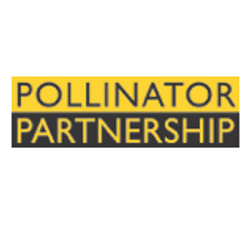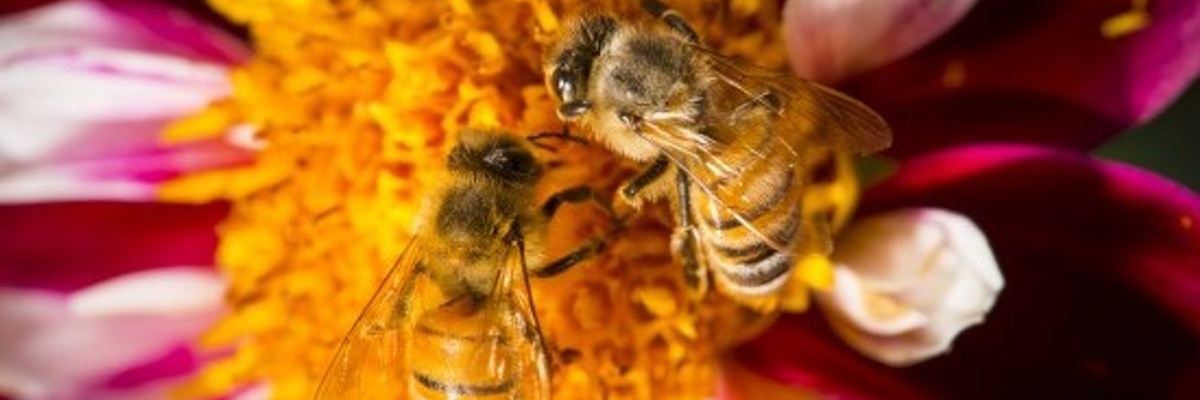

Whether you are a farmer of many acres, land manager of a large tract of land, or a gardener with a small lot, you can increase the number of pollinators in your area by making conscious choices to include plants that provide essential habitat for bees, butterflies, moths, beetles, hummingbirds, and other pollinators. Happy planting!
Whether you are a farmer of many acres, land manager of a large tract of land, or a gardener with a small lot, you can increase the number of pollinators in your area by making conscious choices to include plants that provide essential habitat for bees, butterflies, moths, beetles, hummingbirds, and other pollinators. Happy planting!
April 1 - Despite a temperature of 20F on Monday night, the garden is progressing nicely. I was pleased to see a clump of Virginia bluebells growing at the base of the female gingko tree. Although the buds are pink, the flowers will be blue. The bluebells are a memory of Stefania Powell who created the garden.
A quick look at Journeynorth.org shows the hummingbirds are still hanging out along the North Carolina border. The recent cold weather may have slowed them a bit. The males migrate first and choose their territories then wait (and hope) for a female to arrive.
Monarch butterflies have left their winter quarters in Mexico and are massed along the Texas/Oklahoma border and the Gulf Coast. The butterfly who leaves Mexico won't reach Virginia: it takes three generations to travel here. We should see monarchs in July.
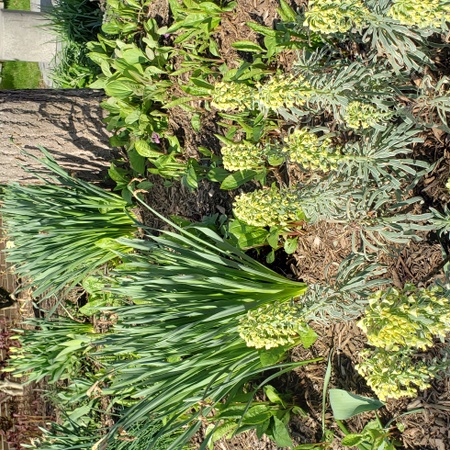
March 23- This week in the garden, the daffodils are fantastic! With rain in the forecast, I drained the rain barrel and used the water to do a little planting and transplanting. In the pollinator garden, the mountain mint (pycnanthemum muticum) is spreading rapidly. I moved an aster October Skies and a veronica Sunny Border Blue out of the mint's clutches. Now the mint has the lower corner of the garden all to itself. In order to spread uphill, it will need to contend with monarda Claire Grace who is a spreader herself.
In the front yard garden I added two leucanthemum Becky. Becky is the quintessential shasta daisy. Let me tell you, Becky is one tough cookie: I have a patch of Becky in the entrance garden at Rippon Lodge. She's growing on a steep slope in the root zone of a redbud tree and blooms reliably. Shasta daisies are listed on all the pollinator garden plant lists but I've never seen bees on Becky. I asked my on-line garden friends "Do bees visit Becky" and the consensus is that if you have a high number of bees, they will use Becky and other shastas. If you only have a few bees and there are tastier flowers available, Becky will be ignored. So Becky isn't the most popular flower with bees but humans can't resist her. At Rippon I frequently find daisy flowers lying on the ground with the petals plucked off. I want to put up a sign reading "Dude, nobody's gonna love you if you pick flowers in a public garden."
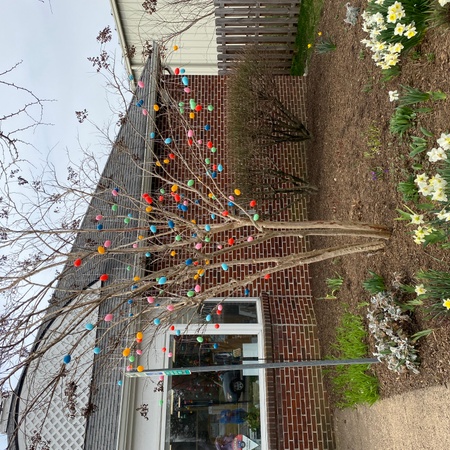



March 21- A glance at journeynorth.org shows that the spring hummingbird migration has begun. The little guys have returned to the US from Central America and are headed our way. (They fly across the Gulf of Mexico!) This week there have been ruby throated hummingbird sightings from Birmingham, AL and Atlanta, GA. Checking maps from previous years shows that they typically arrive in Prince William County in mid April. Since our weather has been warmer than average this year, they may be a little earlier.
March 16- This week in the garden I transplanted half a dozen clumps of allium from another county garden (thanks Ben Lomond!) into the front yard planting bed at our library. Allium is an interesting plant family: it includes onions and chives. Large flowered alliums are a bulb like a culinary onion and they bloom in May producing softball sized balls of bright purple flowers on a tall stalk. If you planted a culinary onion and let it grow, the flower would be a round ball of white flowers about golf ball sized. Sadly the large flowered alliums hate our soil/climate and only survive for a couple of years.
There are small flowered alliums that grow from little onion like bulbs and bloom in spring in shades of purple, pink, yellow and white. There are also small flowered alliums that grow from fibrous roots and bloom in August like chives. Our new alliums are the August bloomers. The dried bloom stalks from 2021 were about eighteen inches tall. I anticipate the flowers will be pink or purple balls. The plant is extremely drought resistant and deer resistant (deer despise alliums of all types). It blooms in August when not much else is flowering and bees LOVE it. Please note George that the new allium's foliage looks similar to the wild onions that are already growing in the front bed.
March 10 - Unseasonably warm temperatures earlier this week inspired me to wear shorts outdoors. After airing my pasty white legs for a couple of hours, I switched back to jeans to avoid a sunburn. It will take a few gradual exposures to develop a base tan. Warmer spring temperatures also send gardeners hurrying to local nurseries in search of flowers. Greenhouse grown blooming plants await us at Meadows Farms and Merrifield Garden Center. Pots of blooming bulbs or pansies or snapdragons or... etc... would look fantastic on the front porch. If you succumb to spring fever and buy plants now, there are a couple of things to keep in mind...
Greenhouse grown plants are not accustomed to bright sunlight (like my legs). The leaves will scorch if you set them out in full sun. The process of gradually acclimating a greenhouse grown plant to outdoor conditions is called "hardening off". Like building a suntan, you keep them in light shade for a day then gradually increase the time spent in full sun.
Spring bulbs bloom for about a week. That pot of tulips, daffodils or hyacinths will be gorgeous for a week. Not a good value.
Deer adore pansies. They will come up to your front porch to eat pansies because they are just that darned tasty.
Cold nights in the 20's mean your pots should go in the garage (Saturday night's forecast looks rough).
The solution to early spring flower cravings is the hellebore aka Lenten rose. Hellebores are perennials with evergreen foliage that bloom for three months from February to late April. The flowers are actually bracts which enables the blooms to persist for so long. A gallon sized potted hellebore costs $30 but the plant grows happily in dry shade and blooms for months. Take a trip to the nursery, enjoy the feeling of being surrounded by blooming plants and choose a hellebore to take home.
March 1 - Attrition is on my mind. I've been reading a book by a famous landscape designer who plans for 20% attrition in new installations (and adds the replacement plant costs into the bill). In a garden designed and installed by professionals, twenty percent of the plants will die in the first year on average. Ouch! Poking around in our new pollinator garden this morning, I saw green leaves at the base of most plants. Given that some plants emerge from dormancy later than others, it's still too early to calculate our rate of attrition but things are looking good.
In my personal garden which is cram jam packed with plants, I don't get upset when a plant dies because that frees up space to try something new. In the Nokesville garden, we will fill in any empty spaces with additional copies of the plants that were especially successful last year. Agastache Blue Fortune bloomed all summer and attracted a high number of pollinators therefore we will add more agastache. When other plants were frost nipped and stopped blooming, aster October Skies kept right on flowering. It bloomed from mid September into December. So we shall add a couple more asters to feed the bees on warm winter days.
The mountain mint (pycnanthemum muticum) has been spreading vigorously over the winter. It never really went dormant but used the cold months to seize territory from its slumbering neighbors. That one may need to be trimmed back.
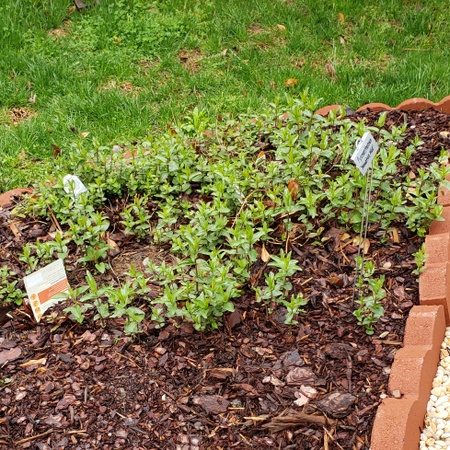
Looking out my bedroom window, I saw a bright blue ball rolling on the lawn. Rushing outside, I broke up the fight: two male bluebirds were out for blood. Later I noticed one of the pugilists attacking his image in the rear view mirror of my car. The songbirds have returned and they are seeking nesting spots. My yard is especially desirable because it contains four bluebird houses. Yes, four bluebird houses are located in a quarter acre suburban yard.
About a decade ago, we were hiking at Shenandoah State Park. The trail along the river had a bluebird house every ten yards. When I asked a ranger, he said that two bluebird families won't live in close proximity but bluebirds aren't the only birds who use those houses. Cavity nesters are birds who live in holes in dead trees. In addition to woodpeckers, cavity nesters also include bluebirds, wrens, chickadees, titmice and house sparrows. So the bird houses are occupied in an ABCDE pattern: bluebird, wren, chickadee, titmouse, sparrow then repeat. So two bluebird families are spaced fifty yards apart and they don't fight. Ditto with the other species. Providing enough houses for every sort of bird who wants one means the bluebirds won't need to fight anybody for a house.
Cavity nesters live in dead trees. How many dead trees are left standing in the suburbs? As suburbs spread inexorably across Prince William County, where are the cavity nesters going to live? I have four bluebird houses and my next door neighbor has four also yet we obviously aren't meeting the demand. Many homeowners maintain bird feeders and bird baths. If those bird lovers were aware of the need for bird houses, would they add one?
The Nokesville Library has a Virginia Bluebird Society regulation nesting box (bird house) located in the front yard near the entrance. Last year a chickadee family called it home. Patrons who visit the library may see the birds using the house and feel inspired to place a bird house in their own yard. The Virginia Bluebird Society web page has house plans and a wealth of other useful information on their web site (www.virginiabluebirds.org)
They're back! My dearest spouse wants to try a recipe from the WaPo food section so I spent an hour searching Lake Ridge grocery stores for obscure ingredients. Seed racks have appeared in the produce/floral sections to tempt winter weary gardeners. Yes, it's way too early to start seeds indoors or out (unless you're growing artichokes) but avid gardeners can't resist purchasing a pack or two. By May, I will own multiple packets of flower seed with no recollection of why I selected them or where they were intended to be planted.
Since we are considering hummingbird flowers this week, when the seed rack beckons you look for cleome aka spider flowers. Cleome is a hummer favorite which does not appeal to bees. It's also ridiculously easy to grow from seed. To grow cleome, rake the mulch back from the planting area and sprinkle the seed on top of the soil. That's it: no fertilizer and no watering is needed. Cleome foliage smells skunky so deer won't eat it. Recap: it grows in average soil, is drought resistant and deer resistant. Sounds like an ideal plant for northern Virginia gardens. Cleome grows to be about three feet tall and blooms in shades of pink or violet all summer. Edge your cleome planting with another great "sprinkle" plant, marigolds. Sprinkle the seed on top of bare soil (don't bury it) and stand back.
The cashier seemed amused when I purchased espresso powder, Dutch process cocoa and flower seed. That's okay, I've always been a weird kid.
Welcome to 2022! Thanks to a generous grant from ChangeX, we were able to install a pollinator garden and provide programming in support of bees last year. Ursula's lovely photos of bees and butterflies brought visitors out to the library and inspired Nokesville gardeners to add pollinator plants to their own gardens. For the new year, we are upgrading the library garden to include a hummingbird feeder and nectar plants preferred by hummingbirds. A hummingbird themed activity for children will be featured in spring.
When selecting plants for hummingbirds, it is important to remember that hummingbirds try to avoid bees. A hummingbird is so tiny that a bee sting will kill it. Since our bees congregate in the library "backyard," the hummingbird feeder and plants will be placed in the "front yard." Bees are red/green colorblind (they don't see the color red) so they primarily feed on blue or purple flowers. That makes red the preferred flower color for hummers. Hummers also choose flowers with long, tubular shaped blooms. Bees can't access the nectar in tubular flowers but that shape is ideal for the long tongue of a hummer. Evolution at work!
Which tubular red flowers are most attractive to hummingbirds? Some flowers contain more nectar than others and some have a longer bloom season. Cuphea, lantana, red agastaches and red salvia are ideal. Unfortunately, these plants are not winter hardy in northern Virginia (they hate cold nights or sodden clay soil or both). The neat solution is to plant them in pots. Many of us like to have pots of color on our decks, patios and front porches. Using hummingbird plants in your pots provides great entertainment watching the little buzz bombers zip around. Hummers are fearless and will hang out on your deck with you!
Over wintering your hummingbird pots means keeping them in the garage during January and February. I have several potted salvias and cuphea that have spent the winter in my dimly lit, unheated garage. I set them out on warm days then put them back in at night. Remarkably, they have bloomed all winter! Of course you could treat them as disposable, and replace them each year like most color pots. Local garden centers carry a nice selection of cuphea, lantana, hybrid salvias and agastaches starting in mid spring. Support a small business, feed hummingbirds and decorate your deck: life is good. Happy gardening in 2022!
Finally posting some pictures of a fantastic library program hosted by Nokesville Library which featured the Prince William Beekeepers Association. Chris Mayes, who provides Education and Outreach services, provided wonderful information on local beekeeping, requirements, equipment, and the Bee School. He was a fount of information and his demonstration hive was fascinating to see up close! We hope to host Chris again in the spring for an audience of children.


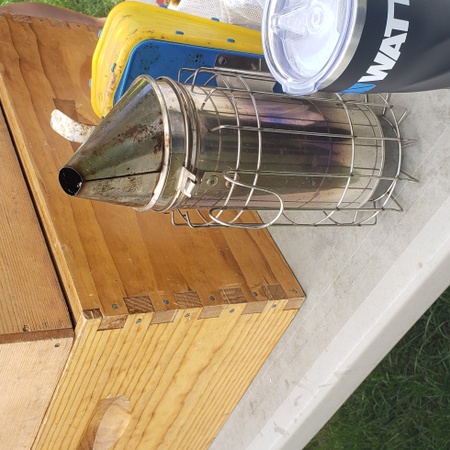
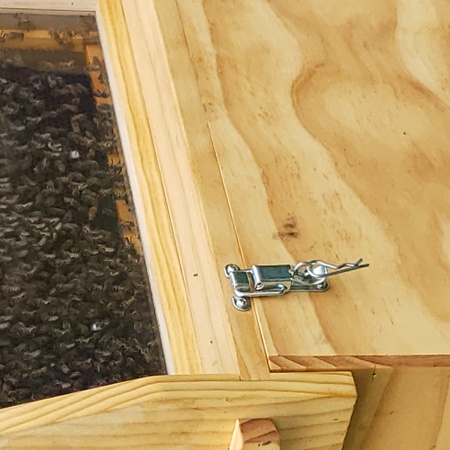
If you enjoyed observing the monarch caterpillers this year, a new treat awaits in 2022: swallowtail cats! A patch of eight bronze fennel plants joined the pollinator garden today. Fennel is a favorite host plant of swallowtails. It also has cool, fluffy foliage. Ours is placed in a hot, dry area along the brick wall of the building. Why such a tough spot? Because fennel prefers very dry soil. It's invasive in southern California but over wintering it in Virginia is a challenge because our soil is typically too wet for it. We gardeners have an emotional need to nurture our plants but fennel will have none of that. If you place it in a hot, dry spot with poor soil it thrives. Plant it in rich soil and water it - it dies.
If you want to raise swallowtail cats but don't have a dry enough place to grow fennel, culinary carrots and parsley are also swallowtail faves. Swallowtail cats resemble monarch cats so strongly, you'll need to use their host plants to guess which is which.
Today in the garden fall planting continued... I'm having the best time nursery crawling looking for end of season clearance sales. Three veronica "Sunny Border Blue" joined the pollinator bed. Sunny Border Blue is a garden stalwart: it was the Perennial Plant Association plant of the year in 1993. Since then, many new veronica hybrids have been introduced in different colors. Since bees prefer blue, we're better off with the old favorite. These three spent several days on my deck waiting to make the journey to Nokesville. On cool mornings I noticed bees sleeping on the flower spikes. So cute!
The front bed under the crabapple gained two lobelia siphilitica. Lobelia siphilitica is a native which sends up spikes of blue flowers in late summer. My garden friends say it spreads prolifically in part shade and dampish soil. Well, it's now planted with cherry bells (pink campanula), obedient plant, and anemone Honorine Jobert which are all prolific spreaders. Will they coexist in peace and harmony? May the best plant win! Actually, these plants are all bee magnets so the bees are the real winners.
Fall is also time for seed saving. If you've been enjoying the orange marigolds in the pollinator garden, be sure to collect seed to grow your own next season. Marigolds are ridiculously easy to grow from seed. In May, just sprinkle the seeds on soft, bare soil. If your garden beds are mulched, rake away the mulch before scattering your marigold seeds. Collect seed husks which are gray and dry with black seeds. Immature seeds are greenish, mature seeds are black. Store them dry and room temperature over the winter (a paper envelope or small cardboard box works well). Scatter them in May 2022.
Thanks to recent rains and hurricane Ida approaching, the soil is thoroughly saturated. I took advantage of this to begin fall planting. Nurseries only sell blooming plants so when we installed the garden last spring we couldn't include fall bloomers. The border of orange marigolds were place holders. Now marigolds are coming out as fall bloomers go in. Today I planted four symphiotrichum October Skies and three pycnanthemum muticum. Also another vernonia Iron Butterfly that I found on sale and three seedling asclepias incarnata joined the garden. I've decided that the greatest challenge in pollinator gardening is to purchase blooming mountain mint (pycnanthemum) and get it into the car without taking bees along for a ride.




It's starting! The fall 2021 monarch butterfly migration has begun. Citizen scientists are reporting monarch roosts in Ontario as they prepare to cross the Great Lakes. You can follow the migration (and report your own monarch sightings) on the website https://journeynorth.org/monarchs
Flapping its wings to dry, it took flight and landed on the nearby bush to rest before flying away. So long!



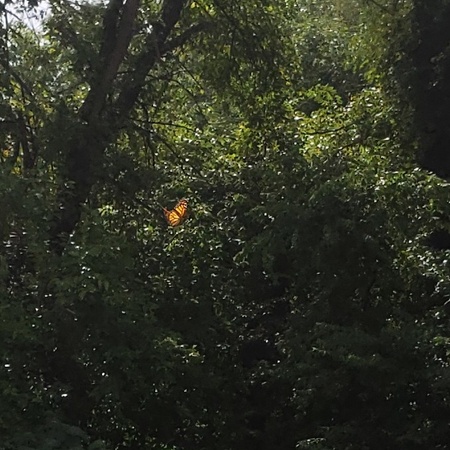
6 Participants
